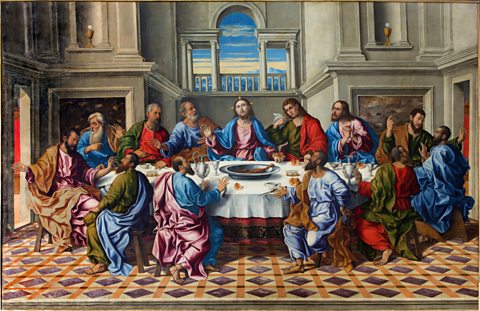The Last Supper (Matthew 26:17-30)
Jesus was celebrating the PassoverJewish festival which remembers the escape of the ancient Israelites from Egypt. meal with his disciples. During the meal he said that one of them would betray him. The disciples were very upset and began to ask him, one after the other, âSurely, Lord, you don't mean me?â Jesus answered, âThe one who dips his bread in the dish with me will betray me.â Judas asked if Jesus meant him, to which he replied âSo you say.â
While they were eating, Jesus took a piece of bread, gave a prayer of thanks, broke it, and gave it to his disciples. âTake and eat itâ he said, âthis is my bodyâ. Then he took a cup, gave thanks to God, and gave it to them saying âThis is my blood, which seals God's covenant, my blood poured out for many for the forgiveness of sins.â Then they sang a hymn and went out to the Mount of Olives.

Background
The Jewish Passover festival is celebrated annually during the month of Nisan (in the spring). It remembers the Exodus â how God rescued the Jewish people from slavery in Egypt
The main focus of the festival is a special meal, where the whole family will gather to hear the story of their ancestorsâ deliverance from slavery. There are a number of symbolic foods which are present on the table or tasted. Some of these include:
- Unleavened bread - this is flat bread baked without yeast. It reminds Jewish people that when their ancestors left Egypt they did so in a hurry and did not have time to prepare bread in the usual way.
- Wine - four glasses are drunk during the telling of the Exodus story to remind the Jews of Godâs promises to his people.
- Bitter herbs - a reminder of the bitterness of slavery.
- Lamb bone - a reminder of the lamb that was sacrificed so that people's door frames could be marked with blood.
- Haroset â a paste of apples, nuts and cinnamon. Its colour and texture are meant to recall mortar, and therefore to act as a reminder of the work of the Israelite slaves who made bricks out of mud.
Understanding the text
Jesus has made arrangements in advance to celebrate the Passover in Jerusalem. Jesus was born and brought up Jewish, so it is natural that he should want to remember this festival with his disciples.
During the meal, Jesus announced that one of his disciples would betray him to the authorities. Judas has already made arrangements with the Jewish leaders to do this for 30 silver coins. This shows that Jesus is fully aware of what will happen to him â that he will be arrested and put to death. Jesus accepts this as he knows it is Godâs plan for him.
Jesus began the Passover in the usual way, but during the meal he made some important changes:
- He broke the bread and passed it to his disciples saying, âTake and eat, this is my body.â
- He offered them the cup of wine, saying âDrink from it, all of you. This is my blood, which seals God's covenant, my blood poured out for many for the forgiveness of sins.â
Passover is the meal at the heart of the Old TestamentThe first part of the Christian Bible which corresponds to the Hebrew Bible but is arranged differently. covenantAn agreement or promise. between God and the Israelites. The Israelites are His chosen people, but they must worship Him exclusively. Jesus has taken the bread and wine and given them a new significance for his followers, showing that a new covenant is about to be put in place between God and His people.
Sacrifice was important in the old covenant. The Israelites frequently sacrificed animals in the temple to receive Godâs blessing and to have their sins forgiven through the blood that was shed. For the first Passover, a lamb or young goat was killed and its blood put on the door frames of the Israelitesâ houses. If they all stayed indoors, then the blood would save their first born when the angel of death visited Egypt that night.
Žł±đČőłÜČőâ blood is about to be spilt at the crucifixionRoman method of execution by nailing someone to a cross, often until they die of asphyxiation; used on Jesus and many others. and the wine represents this. However, Christians believe that through Žł±đČőłÜČőâ blood a person is saved for eternity, not just for a short while.